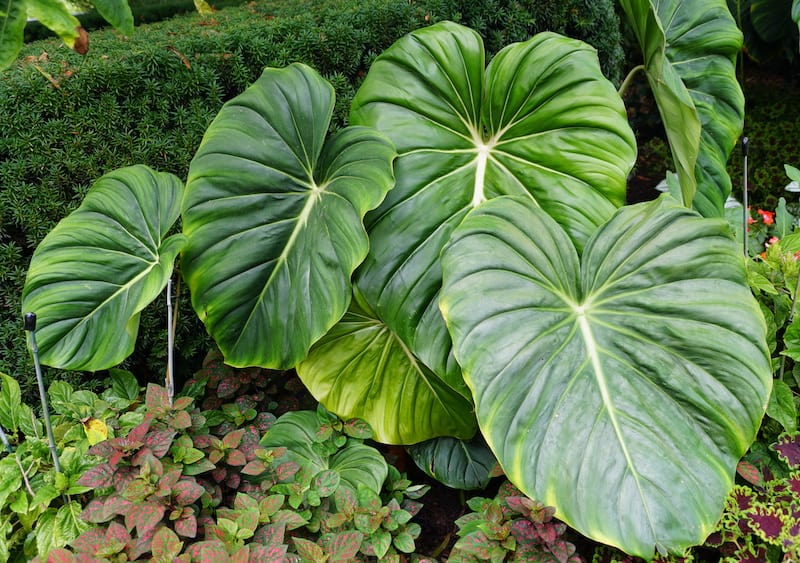The Philodendron McDowell is a beautiful and rare houseplant that looks great indoors and outdoors. It’s easy to care for.
This article covers how to care for the Philodendron McDowell in an indoor environment, including tips on growing it from seed.
Philodendron McDowell Overview
Rare and not easy to procure, the beautiful Philodendron McDowell is a child of crossbreeding between the Philodendron gloriosum and the Philodendron pastazanum.
A member of the Araceae family, this hybrid cultivar is the creation of John Banta and was bred in 1988. It is considered to be named for Banta’s friend, Dean McDowell.
This is a striking philodendron characterized by large, dark green, heart-shaped leaves featuring gorgeous white veins. It can be cultivated as an indoor houseplant or outside. Care and maintenance needs resemble those of other philodendron varieties, making it relatively easy to care for.
This hybrid is considered a ground-dwelling, crawling variety of philodendron, so it will not grow to be overly tall as it prefers trailing. At maturity, it should not grow more than three feet tall, and most likely, a bit less.
However, what it doesn’t achieve in height, it certainly makes up for in its spread of large, puckered leaves. This glorious philodendron can spread to more than six feet wide. Growth will be influenced by environmental factors.

Philodendron McDowell Care Guide
If you wish to cultivate the McDowell outside USDA hardiness zones 9b and 10 are the appropriate areas. Follow these general guidelines to grow healthy plants.
- Read more about Genera Philodendron Plants.
Soil for the Philodendron McDowell
A potting soil mix that is high in organic matter content will make for a happy Philodendron McDowell plant. It’s important to have well-draining soil and to maintain moist soil for the plants to grow healthy.
Blend your potting soil with ingredients such as:
- Coconut coir
- Compost
- Orchid bark
- Peat
- Perlite
- Sphagnum moss
Opt for a light, loose soil mixture as opposed to heavy soils that tend to retain too much water and compact easily. Your soil needs to retain moisture, but not have your plant’s root system swimming in water.
Pots and containers should have plenty of drainage holes to allow for excess water to drain efficiently.
Light for the Philodendron McDowell
The McDowell prefers partial shade and will thrive when light is filtered. Bright indirect light will be best.
It should never be cultivated in a location that exposes it to direct sunlight. Direct light will damage foliage by scorching and burning. When cultivating outdoors, look for a location that offers shade during the day’s sunniest hours.
Partial shade is best as total shade will not provide your hybrid with adequate light. As a tropical plant, the philodendron needs dappled or filtered light.
Water and Humidity for the Philodendron McDowell
Like many tropical plants, the Philodendron McDowell prefers the soil bed to remain consistently moist, but not soggy. Overwatered philodendrons are at risk of developing root rot. But the soil bed cannot be allowed to dry out either.
With a growing medium that is too dry, the green leaves will begin to wilt. When watering, consider using distilled water, filtered water, or collected rainwater. Avoid giving your plant water tap that can be heavy in chlorine or fluoride.
Allow the top two inches of soil to dry before watering. Check if the soil is dry by sticking your finger in the soil. Monitoring the soil will help to avoid both overwatering and underwatering. You can also use a moisture meter.
Philodendrons like high humidity with levels of 60% or higher preferred. If the air in your house is dry, you will need to increase the humidity in the vicinity of your plant. But it can adapt to normal home humidity levels if needed. Growth may not be fast.
This can be done in one of several ways:
- Create a pebble tray to place underneath your plant’s container.
- Use a humidifier.
- Mist your plant regularly.
- Group several plants together. In this way, the natural transpiration of the plants will increase humidity in the immediate area.
Temperature for the Philodendron McDowell
The Philodendron McDowell needs an environmental temperature range that measure between 60° and 80° Fahrenheit.
If you are cultivating your McDowell outside and have a normal winter season, bring your plant indoors in the autumn when temperatures begin to dip.
The McDowell does not tolerate cold and will not survive frost. It is a houseplant that will feel comfortable with indoor temperatures when you feel comfortable.
Fertilizer for the Philodendron McDowell
Philodendrons are not heavy feeders, and the McDowell is no exception, so your plant can get by with little fertilizing.
Feed monthly during the growing season with a high-quality liquid fertilizer that is diluted to half strength. Avoid fertilizing in the winter. Take care to not overfeed as this can result in salt buildup in the soil bed or the burning of roots.
Pruning the Philodendron McDowell
The McDowell will not require a lot of pruning during its first year. When it grows larger, the vines will need a little trimming with sterilized garden shears or scissors. Remove dead, dying, or damaged leaves.
If vines appear erratic, you can remove them. Avoid snipping younger vines unless diseased.
Repotting the Philodendron McDowell
The Philodendron McDowell may arrive in small pots, but as they grow, they will need to have their pot size upgraded to avoid your plant becoming rootbound.
As your plant matures, it will require repotting less often, perhaps every other year because growth slows down considerably as the plant ages.
Apart from preventing roots from binding and crowding, the principal reason for repotting is to refresh the potting mix. After a certain amount of time, the nutrients provided in the soil bed will diminish and your plant will require a source of nutrition.
When repotting, take advantage of the plant being out of the pot and inspect the root system for signs of damage or disease. Trim away any roots in dubious conditions and dispose of them.
Propagating the Philodendron McDowell
A Philodendron McDowell can be propagated either using stem cuttings or with rhizomes. If you are repotting, you can divide the root system, as long as each root section features at least two shoots.
How to Propagate with a Stem Cutting
- Stem cuttings can be cultivated in soil mix or water, and spring is the ideal time.
- With sterilized scissors or garden shears, cut a stem length of approximately four inches long below a leaf node. The cutting should have several leaf nodes.
- If propagating in water, change the water every three to four days. Rooting hormone is not necessary, but can be used as it helps facilitate root growth.
- Once roots measure an inch long, you can transfer the stem cutting to a container.
- For cultivation in potting soil, create a hole with your finger in moist potting soil and place your cutting in the hole. Move the soil around the base of the stem cutting.
- Your cutting should be placed in a warm space with bright indirect light.
- It will take several weeks for roots to form.
Philodendron McDowell Toxicity and Pets
All members of the Philodendron genus are toxic, so the McDowell is also poisonous to pets, according to the ASPCA. That is because they contain calcium oxalate crystals. These crystals can also be toxic to humans, so keep your philodendron away from small children.
Calcium oxalate crystals are the cause of burning, diarrhea, nausea, respiratory problems, and swelling upon contact. The sap will irritate the skin and may be the reason for an allergic reaction. Chewing, eating, or swallowing Philodendrons can provoke kidney failure in pets.
Symptoms of contact with or ingestion of calcium oxalate crystals to watch for include:
- Diarrhea
- Drooling
- Lost appetite
- Mouth sores
- Nausea
- Pawing at the face
- Swallowing problems
- Swelling lips, mouth, and tongue
- Vomiting
Immediately try to rinse out the mouth of your pet if it has chewed this plant. The skin should also be rinsed after direct contact with plant sap.
Call your veterinarian if you observe symptoms. In the event of severe symptoms, go to an animal emergency hospital for treatment as soon as possible.
Philodendron McDowell Pests, Diseases, and Problems
This plant rarely flowers and mostly does so in conservatory settings. The flowers take the form of a spathe with a spadix. If you do not see blooming, don’t worry.
Yellow Leaves on the Philodendron McDowell
The most common reasons that McDowell leaves turn yellow are inadequate light conditions and incorrect watering.
Evaluate if the location of your plant has adequate access to dappled or filtered sunlight. Then check your watering routine for overwatering or for underwatering.
Pests
Pests can be a problem for any houseplant, especially if the plant arrives from the nursery or florist with pests in tow. Check over the plants you purchase at nurseries or garden centers before bringing them home next to your other plants.
The most common pests to be on the lookout for are:
Spider Mites
Spider mites are particularly attracted to dryer soil conditions, so keeping the soil moist will help prevent them from taking up residence. Use insecticidal soap or neem oil as a remedy.
Mealybugs
These pests are easily identifiable because they look like cottony deposits on the plant. Mealybugs are sap suckers and will deplete sap from a plant. Remove any pests you can manually and treat your plant with diluted organic neem oil spray.
Aphids
When new growth is stunted or damaged, it could be that aphids have taken up residence in your plant. Tiny pear-shaped bugs with antennae that can barely be seen by the naked eye do tons of damage. Aphids are sap suckers and feed on the plant’s sap. Insecticidal soap should resolve the problem.
Philodendron McDowell Diseases
Root rot is the largest risk for your Philodendron McDowell. It is a result of overwatering or insufficient drainage.
To revive a plant from root rot:
- Remove the plant from its container.
- Remove any damaged or mushy roots.
- Rinse off the remaining healthy roots and treat with fungicide.
- Replant them in fresh potting soil and a sterilized pot.
- Wait a week before watering.
Bacterial infections and fungal infections are also risks. Overwatering is usually the reason for these illnesses as well.
Reviving infected plants is similar to reviving from root rot:
- Remove all infected parts including leaves, stems, and roots.
- Rinse the remaining healthy roots and treat with fungicide.
- Repot your plant with fresh potting soil and a sterilized pot.
- Wait several days before watering.
Philodendron McDowell Final Thoughts
If you’re looking for a striking houseplant that does not grow too tall but will fill in and decorate a substantial amount of space, consider the Philodendron McDowell with its unique spreading leaves.
The Philodendron McDowell is not easy to find, so it can be expensive, but some nurseries and garden centers will offer it or be able to procure one for you. The large foliage is a distinctive dark deep green will add a bit of tropical flair to your home décor or office.
For more growing guides and how to care for philodendrons, check out these articles:




